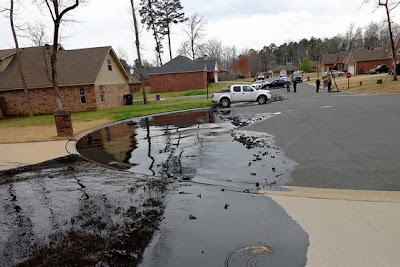 |
| Exxon Mobil pipeline spill in Mayflower, Ark. |
An Exxon Mobil Corp. pipeline rupture caused a major oil spill last month spilled about 5,000 barrels of oil that ran through a Mayflower, Ark., development after a 22-foot split opened.
A Chevron Corp. pipeline in Utah last month that spilled 600 barrels of diesel near the Great Salt Lake, segments of the pipes were made about 60 years ago by bending metal sheets to form a tube, then heating the edges with a low-frequency electric current to weld them lengthwise. Such welds can leave defects in seams that make them vulnerable to corrosion and cracks, risks that have been known for decades. By 1970, most pipe manufacturers began using a high-frequency current to weld, which produced seams less prone to fractures.
The Chevron pipeline appeared to split along the welded seam, according to federal regulators. A Chevron spokesman said while the investigation continues, "Initial indications are that the release may have been the result of a longitudinal seam failure in the pipeline."
The Exxon pipeline gushed about 5,000 barrels of crude into a residential neighborhood through a 22-foot, incision-like break.
Of the 1,151 accidents on liquids pipelines since 2010 reported to federal regulators, 78% don't show what kind of weld was involved, and 85% don't show when the pipe was manufactured, according to a Wall Street Journal review of government data. The Pipeline and Hazardous Materials Safety Administration (PHMSA) says most of the accidents involved very small spills, or weren't related to pipe welds, so operators weren't required to furnish detailed information about them.
But the number of pipeline accidents has been rising; the 364 accidents on liquids pipelines last year were the most since 2008, but fewer than in 2002, according to federal data.
The other chief testing method involves running a robotic device through the interior of the pipe to detect any anomalies. This device, commonly called a "smart pig," has at times failed to catch flaws that later resulted in a rupture. Neither test is foolproof. (WSJ, 4/15/2013)
![[image]](http://si.wsj.net/public/resources/images/MK-CC423_PIPELI_NS_20130415181207.jpg)

No comments:
Post a Comment